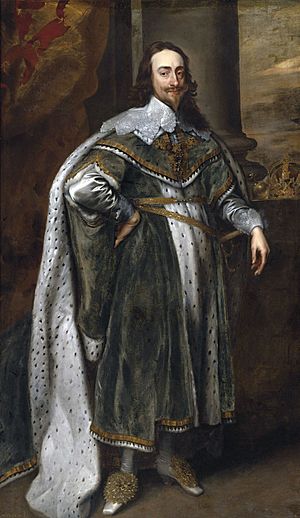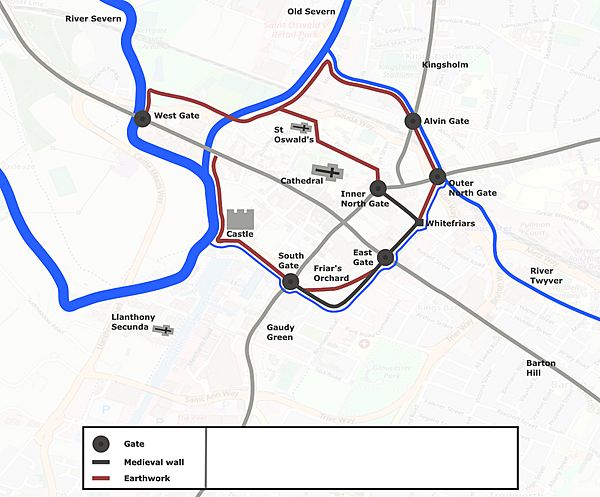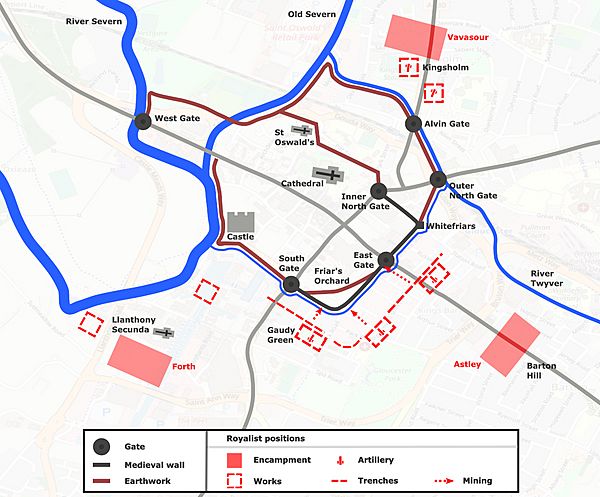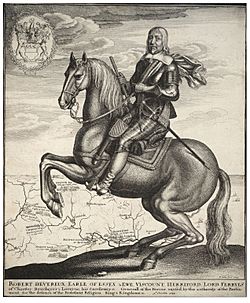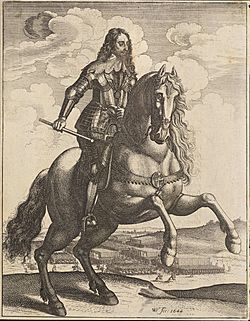Siege of Gloucester facts for kids
Quick facts for kids Siege of Gloucester |
|||||||
|---|---|---|---|---|---|---|---|
| Part of the First English Civil War | |||||||
|
|||||||
| Belligerents | |||||||
| Commanders and leaders | |||||||
| Charles I | Edward Massey Earl of Essex |
||||||
| Strength | |||||||
| 15,650+ | 1,500 (Gloucester) 15,000 (Relief army) |
||||||
| Casualties and losses | |||||||
| 1 killed 800 desertions |
30–50 killed | ||||||
The siege of Gloucester was a big event during the First English Civil War. It happened between August 10 and September 5, 1643. King Charles I and his Royalist army tried to take control of the city of Gloucester. This was part of their plan to control the Severn Valley.
The Royalists had just captured Bristol after a tough fight. King Charles I hoped Gloucester would surrender easily. But the city, led by Lieutenant-Colonel Edward Massey, refused to give up. So, the Royalists tried to force them to surrender by attacking the city walls.
Massey and his Parliamentarian defenders fought back hard. They often raided the Royalist positions outside the city. The Royalist cannons were not strong enough to break the city walls. They also started to run out of ammunition. So, they tried to dig tunnels, called mines, under the city walls.
Just as the Royalist miners were close to breaking through, a Parliamentarian army arrived. This army was led by the Earl of Essex. His arrival forced King Charles I to give up the siege and leave Gloucester.
Contents
Why Gloucester Was Important
After a major battle in 1642, King Charles I only controlled parts of England. These included Cornwall, Wales, and an area around Oxford. Oxford was where he set up his wartime capital.
Gloucester was a strong Parliamentarian city with about 5,000 people. It was important because it threatened Oxford. It also blocked the Royalists from getting new soldiers from Wales. Controlling Gloucester and Bristol was key for both sides.
In early 1643, Prince Rupert, a Royalist commander, tried to take Gloucester. But he didn't have enough soldiers. Later, a Welsh army tried to attack from across the River Severn. But a Parliamentarian army defeated them.
After a big Parliamentarian defeat in July 1643, Bristol and Gloucester were in danger. Prince Rupert captured Bristol, but it was a very costly victory. Many Royalist soldiers were hurt or killed. King Charles I then decided to go to Bristol himself. He wanted to figure out the next steps.
Some of the King's advisors wanted to march straight to London to end the war. But King Charles I decided to attack Gloucester instead. He hoped the city would surrender quickly without a fight. On August 6, Governor Edward Massey refused to surrender. But he secretly hinted he might if the King led the attack. Charles thought this was his best chance to take Gloucester easily.
Gloucester's Strong Defenses
Gloucester was naturally well-protected. The River Severn was on its west side. To the north and northeast, the ground was marshy and hard for an army to cross. This meant attacks could only come from the east and south.
Over time, the city had grown beyond its old medieval walls. Only parts of these walls remained. After Bristol fell, the people of Gloucester quickly built new defenses. They added earthworks and a narrow ditch filled with water. These new defenses connected the old walls.
They also built new earthworks to the north. The River Twyver acted like a moat in some places. The city also had a ruined castle and fortified gates. They even dammed a river to flood the ground, making it harder for attackers.
The city's army had about 1,500 soldiers. Most were from two regiments, each with about 600 men. One was from London, and the other was a local "Town Regiment." They also had some cavalry and about a dozen cannons. The London soldiers were experienced, but the local ones were very motivated to defend their home.
The city had enough food but not much gunpowder. Governor Massey was a strong leader. He worked with the city's leaders to prepare for the siege. They paid the soldiers and made civilians help build defenses. This helped keep everyone's spirits high.
The Siege Begins
As King Charles I marched to Gloucester, more Royalist soldiers joined him. By August 10, about 8,500 Royalist soldiers surrounded the city. King Charles I set up his base at Matson House. He demanded Gloucester surrender, but the city bravely refused. The Parliamentarians then burned down the buildings outside the city walls. This cleared the area and removed any cover for the Royalists.
King Charles I was surprised by their refusal. He had expected a quick surrender. Now, he decided to lay siege to the city. His commanders believed they could take the city in ten days. They thought Gloucester's defenses were weak and that any relief army could be easily defeated.
First Ten Days of Fighting
The fighting started on the afternoon of August 10. Royalist forces began digging trenches close to the city walls. By the next morning, their trenches were only about 130 yards away. This put both sides within musket range.
Governor Massey used surprise attacks to slow down the Royalists. Small groups of Parliamentarian soldiers raided the Royalist trenches. They captured men, tools, and weapons. On August 12, more Royalist soldiers arrived, bringing the total to over 18,000. These new troops also faced Parliamentarian raids.
On August 12, the Royalists set up their cannons. They had two large 24-pounder cannons and a 12-pounder. They started firing at the city walls on August 13. But their cannons were not strong enough to do much damage. One of their biggest cannons even exploded when it was first used!
Massey quickly reinforced the walls with earth and woolsacks. This made the defenses even stronger. The Royalists tried to drain the ditch around the walls by mining. But they didn't follow up with an attack. By the end of August 14, the Royalist cannons stopped firing. They had run out of ammunition.
On August 16, the Parliamentarians launched their biggest raid yet. About 150 musketeers attacked Royalist trenches. They claimed to have killed many Royalists. The Royalists, low on gunpowder, focused on digging tunnels under the walls. These tunnels were meant to fill the moat and then collapse the walls. This was slow work.
On August 18, the Parliamentarians raided again. They disabled four Royalist cannons. Another raid involved cavalry, but it didn't do much. King Charles I returned to Gloucester with 1,000 more soldiers. By August 19, the Royalists resumed their bombardment. But with limited ammunition, it didn't cause much damage. The Royalists had failed to take Gloucester in ten days. Their cannons were not good enough, and Massey's defense was too strong.
Royalists Focus on Mining
On August 21, the Parliamentarians launched one last big raid. They tried to disable Royalist cannons to the south and east. One group went by boat, and another attacked from the north gate. But the attack didn't go as planned. This showed that such raids were risky and used up too much precious ammunition. After this, the Parliamentarians stopped large-scale attacks.
The Royalists now focused on their mining efforts. They were digging tunnels towards the east gate. They also tried to convince the city to surrender. Royalist cavalry even staged a fake battle to trick the defenders into thinking a relief army had arrived. The Royalists kept firing cannons, but they were so low on ammunition they even fired stones!
On August 26, King Charles I and Prince Rupert went to Oxford. They heard that the Earl of Essex was gathering a Parliamentarian army in London. They decided to continue the siege. They also made plans to block Essex if he tried to relieve Gloucester.
Essex began his march from London on August 26. He wanted to reach Gloucester without a major battle. He knew the Royalists had more cavalry, which would be an advantage in open country. So, he chose a route that avoided open fields. By early September, Essex had a large army of about 15,000 soldiers and many cannons.
The Royalists continued digging their mines. They focused on the tunnel under the east gate. Massey's defenders also dug tunnels to try and find the Royalist mines. On September 1, Massey built new defenses at Friars Orchard. He placed cannons there to stop any Royalists who broke through.
On September 3, the Parliamentarians used a cannon to fire at the Royalist miners. The Royalists fired back, and the cannon was pulled away. The Royalists expected their mine to reach the east gate the next day. They believed Essex's army would be delayed for several more days.
Essex's Army Arrives
By the end of September 3, Essex's army was close to Gloucester. The Royalist cavalry, led by Prince Rupert, tried to stop them. But Rupert was surprised by how large and well-handled Essex's army was. He failed to delay them.
Inside Gloucester, the defenders saw Royalists moving away sick soldiers and some cannons. But they also saw 2,500 Royalist reinforcements arrive. The defenders' counter-mine reached the Royalist mine outside the east gate. They were critically low on gunpowder. But they saw fires on a nearby hill, which was a signal that Essex was close!
On September 5, Essex's army began descending a steep hill towards Cheltenham. Prince Rupert was not in a position to stop them. He returned to Gloucester to cover the Royalist army as they left the siege. King Charles I had already left his headquarters. The defenders in Gloucester didn't quite believe the siege was over. They stayed alert behind their walls.
What Happened Next
The Royalists suffered many losses during the siege, with estimates ranging from 1,000 to over 1,500 soldiers killed, wounded, or deserting. The Parliamentarians lost only about 30 to 50 soldiers. The city was very close to running out of gunpowder. If the Royalists had launched a direct attack, the city might have fallen. But King Charles I didn't want to risk more casualties.
Massey's aggressive defense was key to Gloucester's success. His surprise attacks and counter-mining kept the Royalists off balance. The Royalist cannons were not effective. They fired hundreds of cannonballs but caused little damage.
Even though the Royalists failed at Gloucester, the campaign gave King Charles I a chance to defeat Essex's army. Essex's army had been drawn out of London's strong defenses into open country. The Royalists had more cavalry, which was a big advantage in open battles.
After the siege, Essex's goal was to get his army back to London safely. He marched north to Tewkesbury to trick King Charles I. When Charles followed him, Essex quickly turned back towards Cheltenham. This allowed Essex to march back into the Cotswolds. He even defeated a Royalist group at Cirencester on September 16.
Essex then continued towards London. King Charles I finally caught up with him at the First Battle of Newbury on September 20. But Charles failed to defeat Essex. This allowed the Parliamentarian army to reach London safely four days later.
Gloucester remained an important Parliamentarian city for the rest of the war. However, Governor Massey was removed in 1645 because some doubted his loyalty. After the war, King Charles II ordered Gloucester's walls to be torn down.
Interestingly, some people believe the nursery rhyme "Humpty Dumpty" might be about a siege engine used at Gloucester. This idea came from a professor in 1956, but there's no real proof it's true. In 2009, "Gloucester Day" was brought back. This tradition celebrates the lifting of the siege and had stopped in the 1800s.
Images for kids


